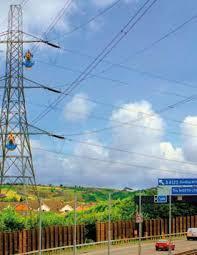
At the recent FT Future of Mobility summit, National Grid project director for electric vehicles Graeme Cooper presented on the future of road transport. Motor Transport caught up with him to take a more detailed look at the role of the grid in enabling electric vehicle charging.
While HGVs powered by battery electric or hydrogen fuel cells are still some way off volume production, the current UK government’s vision of a net-zero carbon emissions economy by 2050 means fossil fuels’ days are numbered.
But switching long distance heavy road transport away from diesel will require much more than just developing low emissions vehicles. Battery electric trucks will need recharging both at base and on the road while producing hydrogen in large volumes will also require abundant electricity, preferably from low carbon renewable sources such as wind or solar.
To connect low emissions vehicles with the sources of energy when and where needed will involve significant investment in the electricity grid, which is run in England and Wales by National Grid. Its project director for electric vehicles Graeme Cooper told MT the company already has plans in place to make sure power will be available where and when it needs to be.
Making connections
National Grid runs the national high voltage transmission network connecting power stations and renewable energy sources to the 14 regional distribution network operators (DNOs) that supply electricity to customers.
“They are all connected and they all need to work together,” said Cooper. “We don’t make or sell electricity; we just allow it to flow to where it’s needed. We are very confident that the way the energy industry is making electricity cleaner all the time means we will have the volume of green juice we need to decarbonise transport.
“The next element is: how do you get it to the right place?”
For the foreseeable future, battery electric vehicles – especially HGVs – will not have the range to complete long journeys without recharging en route.
Luckily when it comes to providing more on the road recharging capacity the National Grid infrastructure often follows trunk roads.
“When you’re out on the motorways just count the pylons,” says Cooper. “There is about a 60% synergy between the strategic road network and our network. To provide coverage for 99.6% of the roads for 50 driven miles we worked out there are 54 strategic sites in England Wales. Nearly all of them are on existing motorway service areas.

There are around 85 MSAs in total in England and Wales.
At those sites National Grid envisages there would also be hydrogen production by electrolysis to power fuel cell vehicles as well as recharging batteries.
Not all those connections would be provided by National Grid itself, as the local DNOs would also have a role.
“The transport sector doesn’t care who owns the wires,” says Cooper. “They need a network that gives the right connection with the right capacity at the right price so there is a consistency across the UK. Those 54 sites will be a mixture depending on who is able to deliver most effectively.
“National Grid has identified the sites and we will work with government, the motorway service areas and the industry sectors to see how those are delivered.”
National Grid is a licensed monopoly, regulated by Ofgem, and also operates the national high pressure gas grid, so has to be “technology agnostic”, Cooper insists.
“We are just responding to what we see in the market,” he says. “Networks respond to customer demand and at the moment we see a new customer likely to come forward and that is the decarbonisation of road transport. But it is very difficult for us to respond to a market that is starting to form.
“Instead of just responding after the event we are hoping to help government and industry and the players by asking ‘what is the infrastructure you need, when do you need it and what does it look like?’ We have tried to help the sectors come together to find the answers and understand what we need to do to make sure our infrastructure is an enabler for a low carbon future not a barrier.”
Stranded assets
What Ofgem will be keen to avoid however is the risk of ‘stranded assets’, built on a contingency basis but ultimately in the wrong place.
“Do we put something in and suddenly there is a technology change that means it is a wasted asset?” says Cooper. “It is not for us to decide if it is electric or hydrogen – we are here to serve whatever turns up. We will not be doing the refuelling – we just bring the appropriate grid capacity.”
An “appropriate” future-proofed MSA grid connection will probably be around 10MW to 12MW. “No one can second guess the end state,” says Cooper. “But we run the risk of the perfect being the enemy of the good. We believe that, in the debate around how the energy industry helps the transport industry achieve its objectives, that is the minimum viable product. We feel that is the best way to do it rather than just wait and see what the market does.”
Balancing act
Another challenge for the National Grid is balancing increasingly intermittent generation from renewable sources such as wind and solar with these very large local loads.
“In a future where we have more variable generation we will need more variable demand,” says Cooper. “So flexibility in the energy system will become even more important as we become more decentralised and cleaner in our energy provision. We are already starting to see large-scale battery storage projects applied to grid connections. At charge points on a MSA what you may start to see is battery storage between the grid and the vehicle charging point to flex demand on the grid.
“Hydrogen also has a role because you can make hydrogen at time when the grid is cheap and clean and store it in a pressurised vessel to put into a vehicle. So the solution is not likely to be a wire from the grid to a truck – there is likely to be something else associated with the refuelling. That is not very different from the way MSAs buy and bunker their diesel today.”
This process will be made easier if the government passes legislation requiring all electric vehicles to be connected to the grid via smart chargers that can communicate with the whole network. This will enable better decisions to be made about when EVs should take power from the grid, allowing better balancing of the network without the need to bring on non-renewable generation.
“Charging is getting smarter and the ability of the generation to meet the demand by being able to see what is happening is improving all the time,” says Cooper. “My electric car at home is already only charged when demand is low and the grid is clean. That means my car isn’t charging on a cold winter morning when demand is at peak. That technology is already there and there is no reason to think it won’t find its way into the commercial sector.”
Back at base
As and when large HGV fleet move to battery or hydrogen electric trucks, they will also need high capacity electricity connections at their bases to recharge the vehicles. Most DCs today are in key geographical locations chosen to serve customers in the most efficient way, and these are not necessarily close to the electricity grid.
“We are trying to bring three industries – energy, transport and digital – together,” says Cooper. “I can bring the energy component but we need people to step up with the vehicle and technology components. Trying to get grid capacity to a legacy depot can be expensive and challenging. Some of the discussions we are starting to have are around ‘is there an opportunity to plan moving your big fleet depot to where there is power capacity?’
“National Grid has 346 sub-stations in the UK and we have capacity at each of those. We are having early discussions with some of these big fleets about could they consider, when the lease is up on their current yards, planning to relocate to where the power is rather than trying to dig long expensive routes to bring power to where they are.
“You can look on the National Grid website and see where all those 346 sub-stations are so there is an opportunity for the large fleets to relocate their depots to where the grid capacity is. The value of land is set by the property you can put on it and people don’t want their offices or homes next to a sub-station or under a pylon. But trucks and buses don’t care.”














